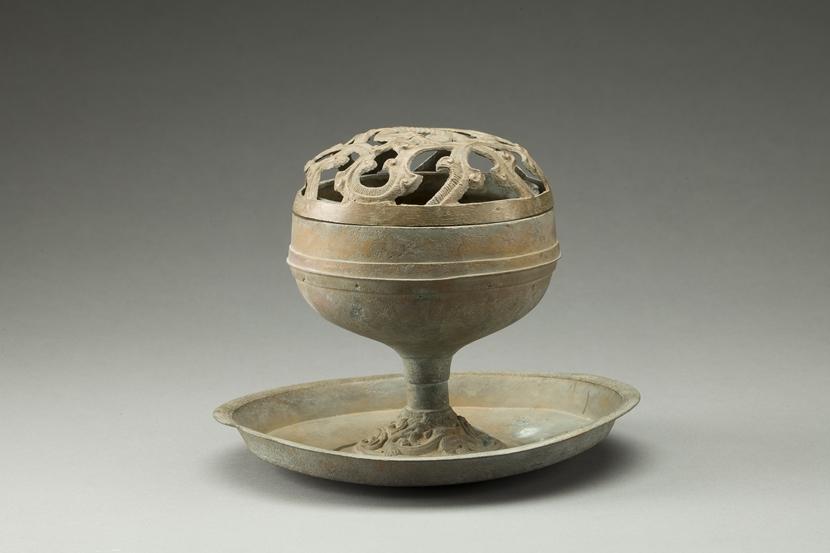A journey through the Han Dynasty in ten objects

The Han Dynasty (206 BC - AD 220) was one of the longest surviving Chinese dynasties and rivalled the almost contemporary, but smaller Roman Empire. Following a period of civil war after the succession of Qin Shi Huang’s son in the Qin Dynasty, rebel leader Liu Bang defeated his rivals and became Han Gaozu, the First Emperor of the Western Han Dynasty. Spanning more than 400 years with only minor interruptions, the Dynasty was characterised by significant advances in science, technology, mathematics, astronomy and literature which can still be felt in China today. Explore this golden age of Chinese history through some of the objects that feature in our China’s First Emperor and the Terracotta Warriors exhibition:
Terracotta cavalrymen and horses

The rulers of the Han Dynasty followed in the footsteps of the Qin kings and showed a strong belief in gods, spirits and the afterlife. Discoveries so far suggest that, like the First Emperor of China, they had armies of terracotta warriors and horses to protect them, as well as servants, entertainers and animals. These cavalrymen and horses are two of more than 500 figures buried near the tomb of a general at Yangjiawan. Originally, the cavalrymen held the reins in one hand and a weapon in the other, and details of the saddles, harnesses and bridles were painted on the figures with bright colours.
Animal mask

People decorated many objects with images of wild and mysteries animals during the Qin and Han periods. In the Han Dynasty, the animal mask became a popular motif used to decorate the handles of various objects such as doors, vessels and coffins. This ornamental handle was probably attached to a coffin, and is missing a bronze ring which would have hung from the mouth of the creature.
Jade disc

A comparison of major tombs dating from the Spring and Autumn Period (771 - 476 BC) to the Han Dynasty, reveal a great increase in the use of jade between the third and second centuries BC. Jade was more valuable than gold as it was strongly associated with immortality, and its use was restricted to the highest members of society. Coffins of high-ranking individuals were embellished with protective jade discs such as this one which is the largest ever discovered in China. The hole in the centre of the disc is designed to allow the spirit of the deceased to travel in and out.
Pottery model of a well

Models of buildings and real-life objects such as houses, granaries, cooking stoves and wells were very popular in the Han Dynasty, and were produced specifically for burial in tombs. This was not the life-sized world of the scale created by China’s First Emperor, but miniature versions of the world the deceased had lived in. In modern China, many people still believe in the afterlife and worship their ancestors in cemeteries or at home. They buy miniature paper models of servants, horses, houses, cars, money and even iPhones as offerings for their relatives so they can enjoy their life in the next world.
Gold ingots

Emperors used gold ingots as gifts to reward their subjects or as gold reserves to store their wealth. Many ingots were stamped or engraved with inscriptions such as family names or good luck messages, and more than 400 gold ingots dating to the Han Dynasty have been found in China so far.
Pottery zun 樽 wine container

Containers of this shape were made to store liquors such as wine. Ancient Chinese wine was made from fermented grain and rice wine is still one of the most popular drinks in China today. This green glazed pottery ‘zun’ is decorated with cloud designs around the sides. Its lid is in the shape of a mountain; probably representing the mythical ‘Isles of the Immortals’.
Tomb doorway

It was common for wealthy individuals to have a stone door built at the entrance of their tomb which was carved with images of mythical creatures to guard against evil spirits. On the lintel at the top of this doorway, the sun is shown on the right as a red circle with a black bird, while the moon appears as a circle on the left. Together with the clouds depicted on the doorframe, they represent a celestial space high above the human realm. Images of dancing figures and chariots on the doorframe illustrate the activities at the tomb site during the ceremonial service. Two immortals in black at the top on each side of the doorframe are poised ready to guide the deceased to heaven.
Coins with Greek script

Bearing Parthian-style Greek inscriptions on one side and decorated with a Han-style dragon on the reverse, these coins offer a glimpse into the cultural exchange between China, Greece and Central Asia via the Silk Road. The establishment of this huge network of trade routes linking China to the Mediterranean extended over 7,000 kilometres and created new opportunities for Chinese merchants who traded silk, lacquerware and salt in exchange for gold, jade, silver, ivory, glass, spices and exotic goods.
Brass incense burner

Up until the Han Dynasty, people burned fragrant plants as incense. In later times, it became more common to heat scented wood with charcoal. Exotic incense imported via the Silk Road became one of the most expensive goods traded in the Han Dynasty. Discover more fascinating objects from the Han Dynasty at our landmark exhibition, China’s First Emperor and the Terracotta Warriors which runs from 9 February until 28 October 2018.
